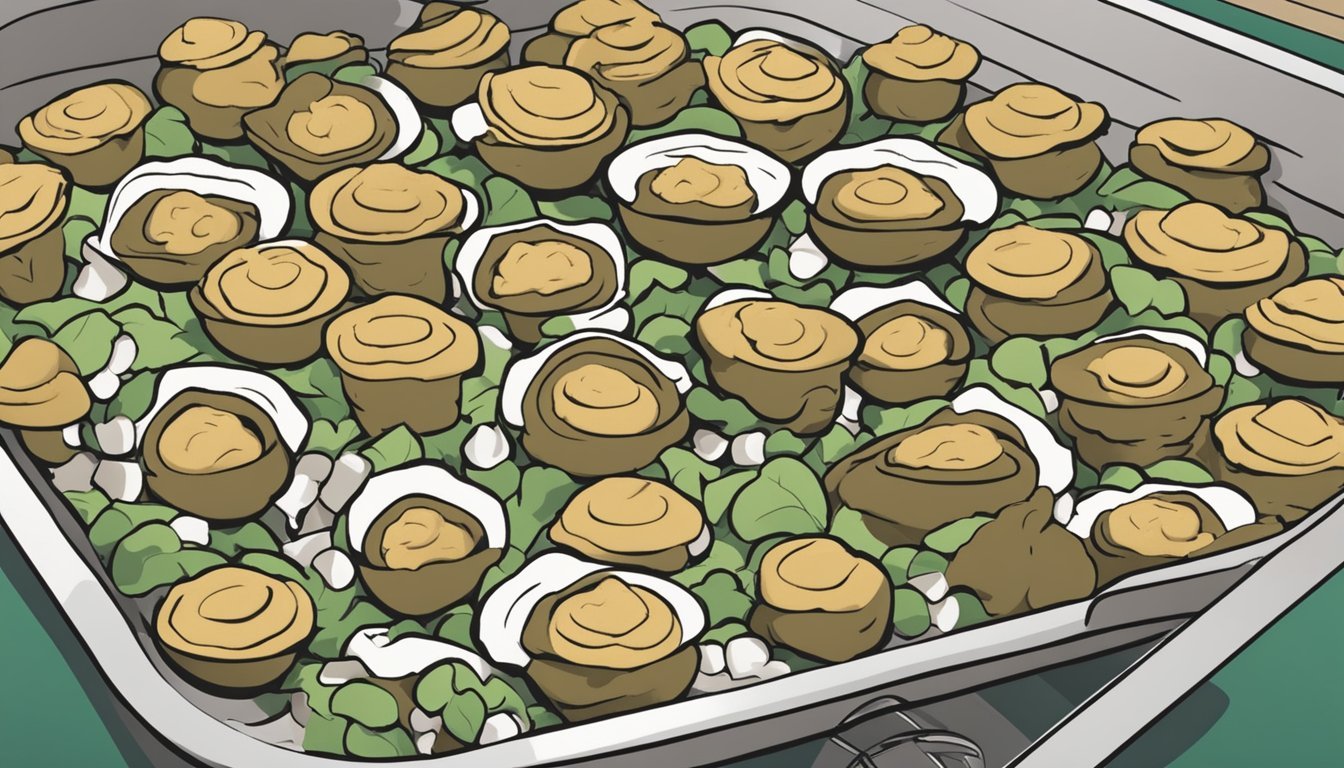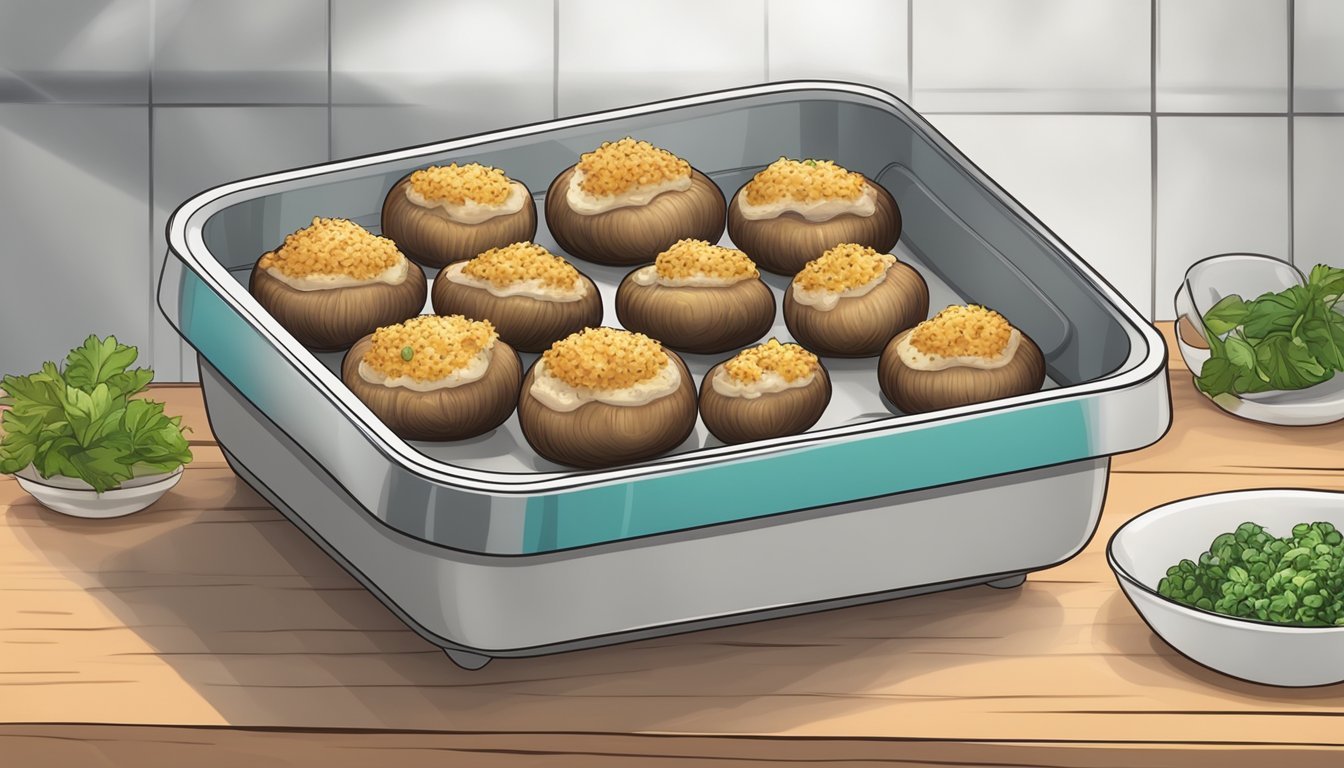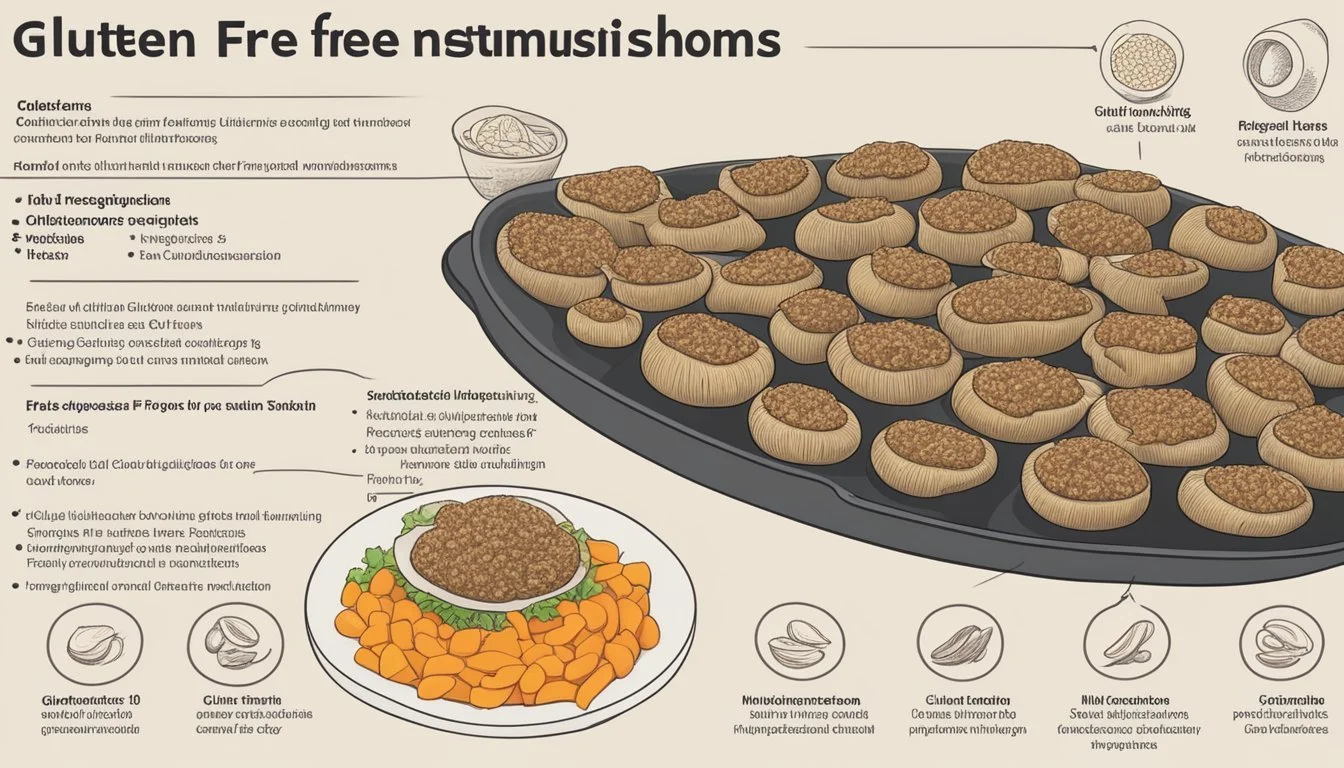How to Reheat Gluten-Free Stuffed Mushrooms for Optimal Flavor and Texture
Reheating gluten-free stuffed mushrooms can be an easy process with great results. These savory appetizers make for perfect leftovers, ensuring that no delicious bite goes to waste. To maintain the mushrooms' flavor and texture, it's important to follow the right reheating techniques.
To achieve the best outcome, place your leftover stuffed mushrooms in a skillet over low heat with a tablespoon of olive oil and cook for 5-7 minutes. This method helps retain moisture and prevents them from becoming rubbery. Another effective way is to reheat them in the oven at 350°F, adding a few tablespoons of water to your baking dish to produce steam.
Microwaving is a quick alternative, but it can sometimes result in uneven heating. If you choose this route, use a microwave-safe dish and cover the mushrooms with a damp paper towel to add moisture. By following these methods, your gluten-free stuffed mushrooms will taste as fantastic as when they were first baked.
The Basics of Gluten-Free Stuffed Mushrooms
Gluten-free stuffed mushrooms are an excellent appetizer or side dish, combining flavorful fillings with the natural earthiness of mushrooms. It is crucial to ensure that every component, including the mushroom varieties, supports a gluten-free diet.
What Makes Mushrooms Gluten-Free
Mushrooms are naturally gluten-free because they are a type of fungus. They do not contain any gluten proteins that are typically found in grains like wheat, barley, and rye.
Important Points:
Be cautious with fillings and additions. Ingredients like breadcrumbs, certain cheeses, and pre-packaged seasoning mixes may contain gluten.
Always verify that every added ingredient, such as cream cheese, is certified gluten-free.
Selecting the Right Mushroom Varieties
Choosing the right mushroom variety is essential for making delicious gluten-free stuffed mushrooms.
Common Varieties for Stuffing:
White Mushrooms: They have a mild flavor and are widely available.
Baby Bella Mushrooms / Cremini Mushrooms: These offer a deeper, richer taste compared to white mushrooms.
Portobello Mushrooms: Larger in size and perfect for more substantial fillings.
Preparation Tips:
Remove the mushroom stems and clean the mushroom caps thoroughly.
Opt for fresh, firm mushrooms to ensure they hold up well during stuffing and reheating.
Using these guidelines helps in creating gluten-free stuffed mushrooms that are both flavorful and safe for individuals with gluten sensitivities.
Essential Ingredients for Stuffing
Creating delicious gluten-free stuffed mushrooms demands a careful selection of ingredients. Key components include fresh mushrooms and a variety of tasty fillings that complement each other perfectly.
Choosing Gluten-Free Fillings
Mushrooms: Starting with the main ingredient, select fresh, firm mushrooms. Portobello or cremini mushrooms work well due to their hearty texture.
Gluten-Free Breadcrumbs: Many traditional stuffing recipes use breadcrumbs. Ensure they are gluten-free to maintain the integrity of the dish.
Cheese: Commonly used cheeses include cream cheese and parmesan. They add flavor and richness. For a vegetarian option, these work superbly, while dairy-free versions ensure inclusivity.
Proteins: For non-vegetarian fillings, crumbled bacon or sausage can enhance the taste. Choose gluten-free versions if necessary.
Herbs and Vegetables: Garlic, onion, and parsley are essential. Fresh herbs like thyme and rosemary elevate the dish, adding depth and aroma.
Binder: Eggs often act as a binder to hold the stuffing together. For a vegan option, flaxseeds mixed with water can be used.
Using these specific ingredients ensures a delicious and satisfying gluten-free stuffed mushroom dish.
Preparation of Stuffed Mushrooms
To make delicious gluten-free stuffed mushrooms, it's important to start with thorough cleaning and careful preparation of your ingredients.
Cleaning and Removing Stems
Begin by rinsing the mushrooms carefully to remove any dirt. Pat them dry using a clean cloth or paper towel. It's crucial to ensure the mushrooms are completely dry to avoid soggy textures during cooking.
Next, gently pop off the mushroom stems from the caps. If the stems are resistant, use a small paring knife to assist in removing them. The stems can be chopped finely and included in your stuffing for added flavor and texture.
Scoop out any remaining debris inside the caps using a small spoon, creating a neat cavity for the stuffing. Dry the caps again if needed before proceeding.
Creating the Gluten-Free Stuffing
In a bowl, mix gluten-free breadcrumbs, finely chopped mushroom stems, herbs, and seasonings of choice. Common ingredients include garlic, parsley, and grated cheese. Sauté these ingredients in a skillet with olive oil until they are well combined and fragrant.
Once the mixture is ready, spoon it carefully into the mushroom caps. Ensure each cap is filled generously but not overflowing to prevent the stuffing from spilling out during baking.
Place the stuffed mushrooms on a baking sheet lined with parchment paper, ready to be baked to perfection.
Baking Gluten-Free Stuffed Mushrooms
Baking gluten-free stuffed mushrooms involves properly preparing the baking sheet and oven as well as determining the right cooking times and temperatures for optimal results. Attention to detail ensures that the mushrooms cook evenly and stay delicious.
Preheating and Setting Up
Preheating the oven is crucial. Start by setting the oven temperature to either 350°F or 400°F, depending on your recipe. Line a baking sheet with parchment paper or use nonstick cooking spray to prevent the mushrooms from sticking.
Prepare the mushrooms by rinsing them thoroughly to remove dirt, then pat them dry with paper towels. Remove the stems and, if necessary, scoop out some of the center. Arrange the mushrooms hole-side up on the baking sheet. This setup ensures even cooking and prevents the mushrooms from rolling over.
Example Setup:
Oven temperature: 350°F or 400°F
Baking sheet: Parchment paper or nonstick spray
Mushroom prep: Rinse, dry, de-stem
Cooking Times and Temperatures
Cooking times and temperatures may vary, but generally, bake at 350°F for about 20-25 minutes or at 400°F for 15-20 minutes. Higher temperatures yield a crispier texture, while lower temperatures ensure a juicier filling. Monitor the mushrooms closely during the last five minutes of baking to avoid overcooking.
When baking multiple batches or different fillings, adjust the time accordingly. Remember, stuffed mushrooms should be cooked until the caps are tender, and the filling is hot throughout. Use a food thermometer to verify the internal temperature if needed.
General Guidelines:
Baking at 350°F: 20-25 minutes
Baking at 400°F: 15-20 minutes
Check tenderness and filling temperature
How to Properly Reheat Stuffed Mushrooms
To maintain the taste and texture of stuffed mushrooms, use methods like oven, microwave, and air fryer. Each method requires specific steps to ensure the mushrooms remain moist and flavorful.
Oven Reheating Method
Steps:
Preheat the oven to 325°F for about 30 minutes, depending on your oven.
Place the stuffed mushrooms on a baking sheet lined with parchment paper.
Lightly grease the parchment paper with vegetable oil or butter to prevent sticking.
Arrange the mushrooms in a single layer, ensuring they do not touch.
Reheat for 10-15 minutes, checking periodically to avoid overcooking.
Oven reheating keeps the mushrooms moist while ensuring the stuffing warms up evenly.
Microwave Reheating Method
Steps:
Place the stuffed mushrooms on a microwave-safe plate.
Cover them with a damp paper towel to prevent drying out.
Set the microwave to 50% power to ensure even heating.
Reheat for 1-2 minutes, checking the mushrooms halfway through to avoid overheating.
The microwave method is quick but requires caution to avoid sogginess or uneven heating.
Using an Air Fryer for Reheating
Steps:
Preheat your air fryer to 300°F.
Line the air fryer basket with parchment paper, ensuring proper air flow.
Place the stuffed mushrooms in the basket in a single layer.
Reheat for 5-7 minutes, shaking the basket halfway through for even reheating.
The air fryer method provides a crispy exterior while keeping the stuffing tender.
Storing Leftover Stuffed Mushrooms
Proper storage techniques will keep your leftover stuffed mushrooms fresh and safe to eat. They can be stored in the refrigerator for short-term use or frozen for extended periods.
Refrigeration Best Practices
Refrigerate leftover stuffed mushrooms by first allowing them to cool completely. Place them in an airtight container to prevent moisture loss and cross-contamination with other foods. Ensure the container is sealed tightly to maintain freshness.
Store the container in the fridge at a temperature below 40°F (4°C). Label and date the container to keep track of how long they've been stored. Consume refrigerated mushrooms within 3-4 days to ensure the best taste and prevent spoilage.
If stacking containers, avoid excessive stacking to prevent crushing the mushrooms. Refrigeration helps in maintaining the flavor and texture of the mushrooms while keeping them safe.
Freezing for Extended Storage
For longer storage, freezing is a suitable option. Allow the stuffed mushrooms to cool, then arrange them in a single layer on a baking sheet. Pre-freezing this way prevents the mushrooms from sticking together in the container.
Once frozen solid, transfer the mushrooms to a freezer-safe airtight container or resealable freezer bag. Remove as much air as possible before sealing to prevent freezer burn. Label and date the container for reference.
Frozen stuffed mushrooms can be stored for up to 2-3 months. When ready to eat, thaw them overnight in the fridge before reheating. This method preserves their quality and ensures they remain flavorful.
Nutritional Information and Dietary Considerations
When preparing or reheating gluten-free stuffed mushrooms, it is essential to consider their nutritional profile and adapt the recipe to suit various dietary needs. Attention to caloric content, macronutrient balance, and ingredient choices can help ensure they are both delicious and nutritious.
Counting Calories and Macronutrients
Gluten-free stuffed mushrooms generally feature ingredients like mushrooms, cheese, herbs, and various fillings, each contributing to the overall nutritional value. For a standard serving size of 3-4 mushrooms, expect approximately:
Calories: 100-150 kcal
Protein: 4-6 grams
Fat: 7-10 grams
Carbohydrates: 8-10 grams
Fiber: 1-2 grams
Sugar: 1-2 grams
These values can vary based on the specific ingredients used. Substituting cheese and high-fat ingredients with plant-based or low-fat options can lower calorie and fat content, making them a healthier choice.
Adapting Recipes for Special Diets
To accommodate various dietary restrictions, modifications are crucial. For gluten-free diets, ensure all ingredients, including fillers and seasonings, are certified gluten-free. Dairy-free or vegan adaptations can include plant-based cheeses and non-dairy milk options.
For low-carb diets, focus on high-protein and low-carbohydrate ingredients, avoiding starchy fillers. Paleo-friendly alternatives can utilize nut-based flours and oils. For low-sodium requirements, use fresh herbs and spices instead of salt.
By understanding and utilizing nutritional information and dietary guidelines, gluten-free stuffed mushrooms can be tailored to meet diverse dietary needs without sacrificing flavor or texture.
Serving Suggestions and Pairings
Gluten-free stuffed mushrooms are a versatile dish that can be enjoyed in various settings and paired with different types of meals. Whether served as an appetizer or alongside main courses and salads, they are sure to impress.
As an Appetizer or Side Dish
Stuffed mushrooms make an excellent appetizer or side dish for guests at parties or holiday meals. Their bite-sized nature makes them easy to handle, especially at potlucks or holiday appetizers.
Arrange them on a platter garnished with fresh herbs for a visually appealing presentation. They can be served warm or at room temperature, adding flexibility to your hosting plans.
Serving them with a dipping sauce like a garlic aioli or marinara can elevate the flavors and provide an extra layer of indulgence. Ensure that the sauces are gluten-free to keep the dish suitable for all dietary needs.
Complementary Main Courses and Salads
Pairing gluten-free stuffed mushrooms with main courses and salads adds depth to the meal experience. They complement a wide range of dishes, from roasted poultry to grilled fish.
For a balanced meal, consider serving them with a fresh salad that includes ingredients like arugula, cherry tomatoes, and a light vinaigrette. This adds a refreshing contrast to the richness of the stuffed mushrooms.
In terms of main courses, a roasted chicken or a grilled steak pairs well and can create a satisfying and substantial holiday meal. The earthy flavor of the mushrooms enhances the overall taste profile.
Using the mushrooms as a side dish for vegetarian mains like a quinoa salad or a vegetable stir-fry also provides a nutritious and vibrant option for dietary variations.
Additional Tips for Perfect Stuffed Mushrooms
To ensure your gluten-free stuffed mushrooms turn out perfect every time, consider a few key tips. Focus on achieving a delightful crunchy top and tailoring the recipe to your taste with various customizations.
Achieving a Crunchy Top
A crunchy top adds texture and contrast to the creamy stuffing. Grated parmesan cheese and gluten-free breadcrumbs are essential for creating this effect.
Sprinkle a mix of parmesan cheese and breadcrumbs over the stuffed mushrooms before baking. Drizzle a little olive oil on top to help it crisp up. Bake at 400°F until golden and crunchy.
For an even more delectable finish, consider broiling the mushrooms for the last 2-3 minutes to achieve a perfect crust.
Ideas for Customization
Make these mushrooms your own by incorporating different ingredients. For a fresh twist, add caprese elements like cherry tomatoes and fresh basil.
You can also mix cream cheese for a creamier stuffing, or toss in some finely chopped fresh herbs such as parsley, thyme, or chives.
Experiment with bite-sized variations by using smaller mushroom caps. By customizing your stuffed mushrooms, you can create a dish that suits any palette and occasion effectively.








